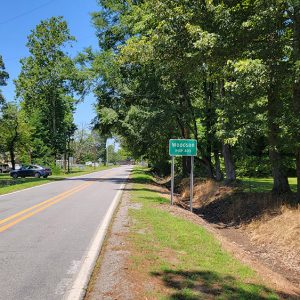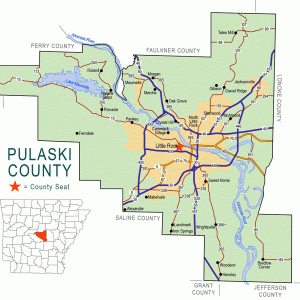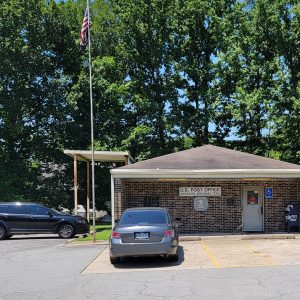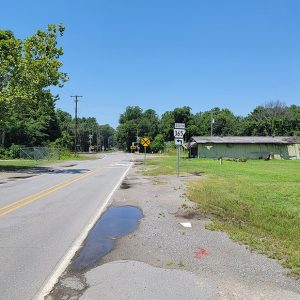calsfoundation@cals.org
Woodson (Pulaski County)
Woodson is a community in southern Pulaski County, north of Hensley (Pulaski County) and east of Interstate 530. Although it was incorporated on January 17, 1882, as a timber town and a stop on the Little Rock, Mississippi River and Texas Railroad, Woodson continued to operate as an unincorporated area, leading to confusion eighty years later.
William D. Pennington acquired land in the area that would become Woodson in 1843. His son, William Q. Pennington, established a post office called Pennington’s Mills in 1855. In 1860, James Jones and John Little also purchased land in the area. The Civil War had little direct impact upon the area during the course of the fighting, but the conclusion of the war reshaped the plantation economy. In 1871, the name of the post office was changed to Campbell, probably to honor Pulaski County Judge William Campbell, who lived just to the south on land that would become Hensley.
Two years later, the county line between Pulaski and Saline counties was moved, and the future communities of Woodson and Hensley became part of Saline County. When the Little Rock, Mississippi River and Texas Railroad was built between Little Rock (Pulaski County) and Pine Bluff (Jefferson County), both Woodson and Hensley became stops on the railroad. As a result of its new prosperity as a rail stop with a sawmill, Woodson incorporated as a town in January 1882. The name of the post office was also changed to Woodson in 1881. The Goodspeed account of Saline County, written a few years later, describes Woodson as “a thriving town in Perkins Township…located in the best farming section of the county. Its population is forty.”
Local lore states that Woodson is named for Ed Wood Sr., who is said to have come from Alabama around 1880. The same lore credits him with helping to found the Prince Hall Masonic Lodge (which in fact dates from 1872). Wood is described as the first African-American plantation owner in Arkansas (another dubious claim). Other explanations for the naming of the town are not available. Meanwhile, the railroad went through several changes of ownership, becoming the St. Louis and Iron Mountain Railroad, the Missouri Pacific Railroad, and eventually the Union Pacific Railroad.
In 1915, the area of Woodson and Hensley was returned to Pulaski County. A highway, running parallel to the railroad, was built between Little Rock and Pine Bluff, with Pulaski County and Jefferson County funding the project. Saline County was unable to contribute money to the project, and so the land was reclaimed by Pulaski County to avoid having to reroute the road farther to the east. By this time, Woodson’s incorporation had been largely neglected, as the town was not electing local officials or collecting taxes from its residents. The U.S. census did not count the residents of Woodson separately from rural county dwellers.
By 1962, the principal landmarks of Woodson were Woodson Baptist Church and Woodson Negro Elementary School. In May of that year, the church and school petitioned the county government to close the westernmost block of Woodson’s four-block-long Main Street. The church planned to build a new sanctuary on the former street, and the school favored the closing of the street to increase safety. Pulaski County Judge Arch Campbell (not related to the earlier Judge Campbell) granted their petition. Several days after the street was closed, twelve citizens of Woodson protested the closing, calling for a new hearing on the matter. During the research leading to the second hearing, records were found verifying the incorporated status of the town, although state law permitted the county judge to dissolve the town’s charter since it had failed to hold elections for more than five years. After further hearings were completed, the street remained closed and the incorporation of Woodson was dissolved. The school was closed, as three small schools for African Americans were consolidated into a new school in Wrightsville (Pulaski County).
Early in the twenty-first century, residents of Woodson began an effort to revitalize their community. They participated in a National Night Out program, applied to the Central Arkansas Planning and Development Commission for a sewer system, and called for stricter law enforcement from the Pulaski County Sheriff’s Office. At that time, the community included eight churches and one store and had recently built a new post office and a park. It also had paved its streets and built a line providing natural gas to homes. The population in the early twenty-first century was about 450 and was mostly African American.
For additional information:
Bentley, George. “Here’s How the Incorporated Town of Woodson Was Forgotten (And May Be Forgotten Again).” Arkansas Gazette, July 17, 1962, p. 1B.
Netterstrom, Kristin. “Residents Making Fair Comeback in Woodson.” Arkansas Democrat-Gazette, July 31, 2006, pp. 1B, 3B.
Steven Teske
Butler Center for Arkansas Studies









Comments
No comments on this entry yet.